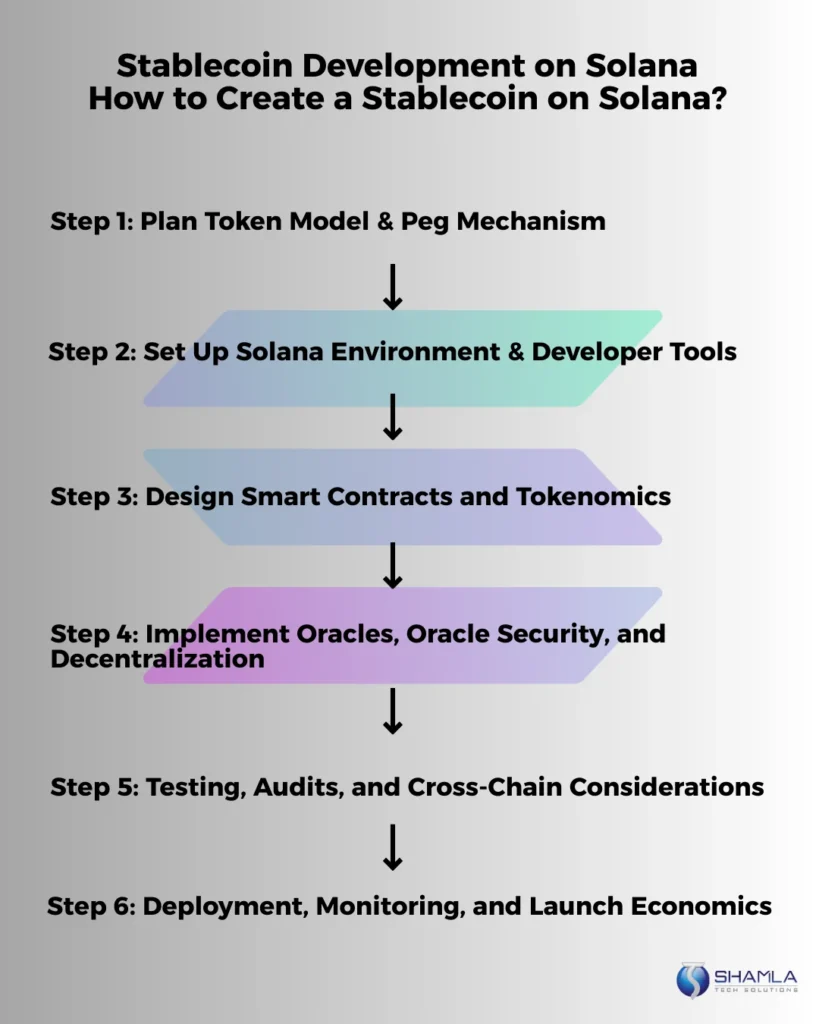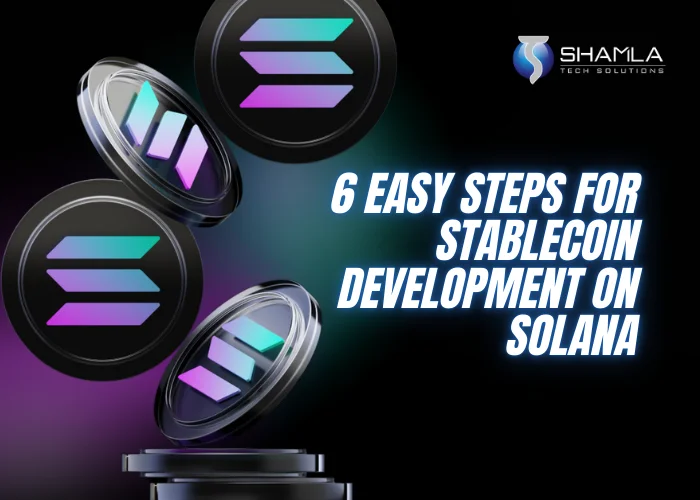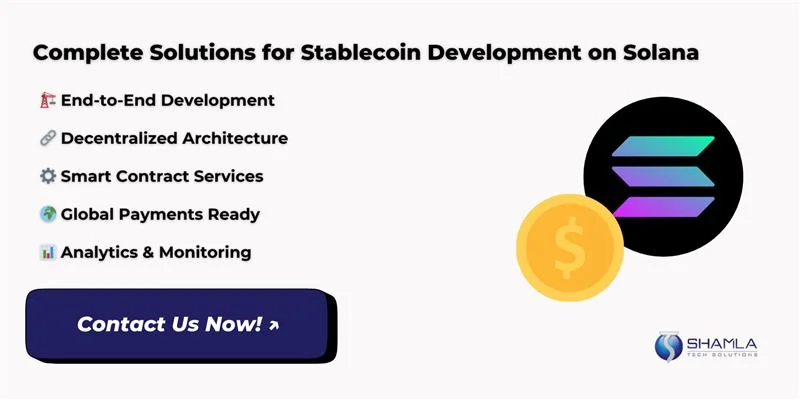Want a fast, low-cost dollar-pegged token? You can build a stablecoin on Solana by minting an SPL token, coding a lightweight Rust program (using Anchor), wiring a price oracle, and adding a simple reserve or algorithm for peg control.
This guide shows the core: token mint rules, mint/burn instructions, authority and multisig setup, oracle feeds for price, on-chain custody of reserves, and basic security checks such as input validation and reentrancy guards. If you need a way on how to create stablecoin on Solana, follow the development flow that we will share below: design token economics, write Anchor program, test on devnet, audit, then deploy to mainnet. This is the shortest clear path to stablecoin development on Solana.
Stablecoin Development on Solana: How to Create a Stablecoin on Solana?

Step 1: Plan Token Model & Peg Mechanism
Start by choosing the peg and reserve approach. For stablecoin development on Solana, decide between fiat-backed, crypto-backed, or algorithmic pegs. Map supply rules, mint/burn triggers, and emergency controls in clear terms. Key checklist:
- Peg type (fiat / crypto / algorithmic)
- Reserve audit rules
- Mint / burn flow and who can call it
Tip: Keep minting simple – fewer moving parts mean fewer bugs.
For teams wondering how to create stablecoin on Solana, document each event (deposit, mint, redeem) and the actors involved. This step also shapes decentralized stablecoin development choices and guides later security tests.
Step 2: Set Up Solana Environment & Developer Tools
Prepare your development stack before writing code. Use the Solana CLI, Anchor framework, and a local test validator. For stablecoin development on Solana, this phase makes builds and tests repeatable. Steps:
- Install Solana CLI and Anchor.
- Run a local validator and create test wallets.
- Configure continuous integration so that tests automatically run whenever new code is pushed.
Tip: Use small scripted deployments to catch permission errors early.
If you evaluate a stablecoin development company, confirm they use the same toolchain and provide stablecoin smart contract development services that include tests and CI.
Step 3: Design Smart Contracts and Tokenomics
Define clear contract roles: vault, mint authority, redemption, and fee logic. The Solana program should be small and separated by responsibility. For teams that want to build a stablecoin on Solana, structure programs so the vault holds collateral, a controller checks the peg, and the mint program issues tokens. Include rate limits and an admin multisig.
Watch transaction budgets: Solana fees are low but many small ops add up. Also estimate the cost of stablecoin development for contract work and testing. Tip: use fixed-size accounts to simplify state and speed up audits.
Step 4: Implement Oracles, Oracle Security, and Decentralization
Feed reliable price data to keep the peg stable. A Solana blockchain stablecoin depends on timely price feeds – use multiple oracle sources and fallbacks. For stablecoin development on Solana implement:
- A primary oracle plus a secondary fallback
- Sanity checks and max-slippage guards
- An emergency pause for bad data
This is central to decentralized stablecoin development: spread data sources and governance to reduce single points of failure.
Tip: Run simulated oracle outages during testing to verify automatic pause and recovery behavior.
Step 5: Testing, Audits, and Cross-Chain Considerations
Thorough testing lowers risk. Run unit tests, fuzz tests, and system tests that cover mint, redeem, rebase, and failure modes. If you plan to build a stablecoin on Solana that moves across chains, design bridges and verify message finality. Hire a stablecoin development company for third-party audits and to implement stablecoin development solutions like formal checks or bug bounties. Quick checklist:
- Unit, integration, and load tests
- Pre-launch audit and fix round
- Bridge security review
Tip: Ask auditors to verify refund and recovery flows specifically.
Step 6: Deployment, Monitoring, and Launch Economics
Deploy in phases: testnet → mainnet beta → full launch.
For a Solana blockchain stablecoin, add on-chain metrics and off-chain dashboards to track peg, reserves, and volume. Factor the cost of stablecoin development for deployment, audits, and monitoring tools into your go-live plan. If you outsource, confirm stablecoin smart contract development services include post-launch monitoring and incident support.
Here’s a checklist to consider to launch a stablecoin on Solana:
- Multisig governance for mint authority
- Automated alerts for peg drift
- Clear user docs for mint and redeem steps
Tip: Start with a small initial supply and increase only after you prove peg stability.
Stablecoin Use Cases and Adoption
1. Payments - Fast Everyday Transfers
Stablecoins let people pay for goods and services fast and with steady value. Merchants accept a token that keeps price stable so buyers do not face sudden changes. Payments finish faster than with banks and often cost less for small buys. Point of sale and web checkouts can add stable tokens using simple code links for wallets and sellers.
These stablecoin use cases reduce wait times and make online and offline checkout smooth and clear. Retailers get faster cash flow and lower fees, while customers see the same value they paid for and easier refunds.
2. Remittances on Solana
Sending money across borders becomes much cheaper with low fee chains. A Solana blockchain stablecoin moves value in seconds and costs very little to send. Families and small businesses keep more of the money when fees and exchange steps are low. Developers build simple cash in links and cash out options to link local banks and shops.
Focus on stablecoin development on Solana helps join wallets, cash points, and local services with clear steps. This work cuts delays and makes cross border pay faster and easier for users. It also reduces hidden fees and cents lost daily globally.
3. DeFi and Available Money
Stable tokens act as a steady base for lending, borrowing, and swaps on many apps. Platforms use stablecoins to let people lend or borrow without moving to bank money. Cross-chain stablecoin solutions let pools draw available money from several chains so trades face less worse price and deeper markets.
That helps traders and savers get fair trades and better returns. Systems that link chains with clear links reduce pockets of idle money and make trading easier. Overall, these stablecoin use cases widen where people can earn and move value safely and cut process time for loans quickly.
4. Hedging and Corporate Treasury
Companies hold stable tokens to protect short term cash from big price moves. Finance teams park money in stable tokens to pay staff, suppliers, and contractors across borders. Cross-chain stablecoin solutions help firms move funds between chains without selling to local bank money.
That saves time and can avoid extra tax steps in some places, and it keeps cash working in simple earnings plans. Companies also use the public record on the chain to show proof of funds fast. Banks watching these models see clearer operations and lower manual work. It gives treasurers speed, fewer errors today.
5. Banks, institutions and Solana's Role
Large banks and funds run tests with token models to speed payments and cut final payments risk. Stablecoin adoption by banks grows when safe storage, clear rules, and simple rails exist for moving funds. A Solana blockchain stablecoin offers low cost and fast final confirmation that suits high volume flows.
Teams building stablecoin development on Solana can follow clear standards for reporting and control to meet bank needs. As firms link to exchanges, gateways and cash partners, stablecoin adoption by banks rises when tools fit rules. These changes make token based cash moves practical for players.
Why Choose Solana for Stablecoin Development?
Stablecoins are designed to reduce price swings, making them safer and more predictable for users. As stablecoins gain popularity, many blockchain platforms now support their development – but Solana stands out as a top choice for Stablecoin development.
Stablecoins on Solana are used by companies, financial institutions, and individuals for purposes like international payments, liquidity management, and protection against currency fluctuations. So, why is Solana ideal for building stablecoins? Let’s explore:
1. High Speed and Scalability
2. Strong Security
3. Developer-Friendly Ecosystem
4. Cross-Chain Compatibility
Solana supports integration with other blockchains, enabling stablecoins to interact across platforms. Cross-chain interoperability provides access to larger liquidity pools and a wider user base, strengthening stability and adoption.
With its speed, security, developer support, and cross-chain capabilities, Solana provides an ideal environment for stablecoin development. It not only meets the demands of modern blockchain projects but also sets a high standard for performance and reliability.
Partner with Shamla Tech to Build a Stablecoin on Solana
Shamla Tech is a trusted partner and stablecoin development company that helps teams build secure, low-cost tokens on Solana. As the best stablecoin development company in USA, we focus on clear code, audits, and simple tools so teams can build a stablecoin on Solana with fast final confirmation and low fees.
Our stablecoin smart contract development services include mint controls, supply rules, upgrade paths, and emergency blocks. We provide stablecoin development solutions that connect wallets, exchanges, and fiat on-ramps.
Why is Shamla Tech the Best Company Stablecoin development on Solana?
- Deep Solana expertise, fast delivery, and clear audits. We cut fees, set oracle feeds, manage keys, and help teams build a stablecoin on Solana without complex steps or surprise costs.
- Proven code templates, repeatable tests, and live monitoring. We run audits, stage upgrades safely, and offer smart contract services with clear logs and simple handover for your team, and support.
- Bank-grade controls with role limits, daily caps, and clear logs. We link fiat rails and exchanges, giving firms safe tools, simple reports for audits, and fast proof for checks today.
- Cross-chain bridges and liquidity tools move value fast. We build token wrappers, pool links, and smart routing so markets stay deep, trades face small gaps, and liquidity stays active daily.
- Dedicated support, quick fixes, and live training for your ops team. We hand over clear docs, run launch drills, offer SLA support, and help you join the pre-sale and start.
Conclusion
Solana offers fast, cheap final settlement and tools that make stable token work for payments, remittances, lending, and cash management. Teams that want to build a stablecoin on Solana should use clear mint rules, oracle feeds, role limits, and tested upgrade paths to avoid breaks.
Cross-chain links boost liquidity and let markets stay deep without selling to fiat. Banks and firms gain speed, lower costs, and clearer records when they adopt proper controls. Use expert help for secure rollout. Start with a clear security plan.
Contact us to Create & Launch your Stablecoin on Solana!
FAQs
1. What is a stablecoin, and how does it work on the Solana blockchain?
2. How can I create a stablecoin on Solana?
Creating a stablecoin on Solana involves several key steps:
- Define the Peg Mechanism: Decide whether the stablecoin will be fiat-backed, crypto-backed, or algorithmic.
- Develop Smart Contracts: Utilize Solana’s smart contract platform to code the logic for minting, burning, and transferring the stablecoin.
- Implement Oracles: Integrate price feeds to maintain the stablecoin’s peg.
- Conduct Testing: Thoroughly test the smart contracts on Solana’s testnet.
- Deploy on Mainnet: After successful testing, deploy the stablecoin on Solana’s mainnet.
3. What are the main use cases for stablecoins on Solana?
Stablecoins on Solana serve various purposes:
- Payments and Remittances: Enable fast, low-cost cross-border transactions.
- Decentralized Finance (DeFi): Provide liquidity for lending, borrowing, and trading platforms.
- Hedging: Allow users to protect against market volatility by holding a stable asset.
- Tokenization of Real-World Assets: Facilitate the representation of physical assets on the blockchain.




